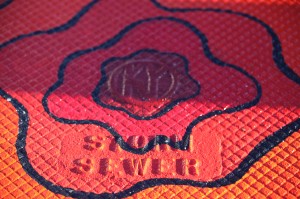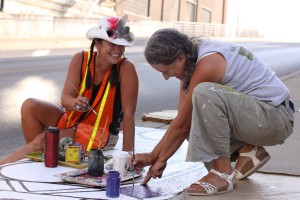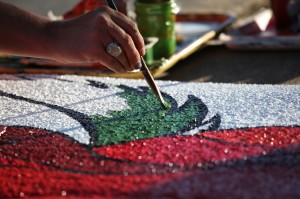Storm sewer education through art
By Beth Connors-Manke
I heard it when I went back to listen to the tapes. Over the course of several weeks, I had talked to Blake Eames and Claudia Michler, always on the street in the heat and grit, always over wet paint. Sometimes they had on fluorescent orange construction vests, with the tan that comes with street work where the sun hits the pavement and comes right back up. Their hair in pigtail braids.
On the tapes were two things: their joy in making art being welcomed by many and the incessant rumbling of cars. As I listened to our conversations, I decided this was the good and bad of it. Art was pleasing them and passersby—this was the good—but the art was a symptom of a variety of failures in our city.
First, the Good
Eames and Michler are the artists responsible for the painted storm sewer drains around downtown, neighborhoods near UK, and the near north side. Made You Look!, their project, won an EcoART grant from the city to help with the storm sewer public education campaign. Their proposal, which sometimes reads like a poem, defines the need at hand:
“Most of us in Fayette County don’t know much about the storm that’s brewing under our feet.
We’re barely aware that we have a storm sewer system that’s wholly separate from the sanitary sewer system.
Barely aware that storm drains exist.
Let alone what they do and why.
Let alone what happens when they don’t work as they should (as is the case right now because they’re ancient and inadequate).
Let alone the fact that when rainwater has nowhere to go, it runs into the storm drain, carrying litter and pollutants with it. And that water runs, untreated, directly into our lakes and streams.”
Therefore, they proposed “to transform select storm drains in high visibility areas in downtown Lexington into fanciful artistic images.”
Surely you’ve seen some of them, been startled when you saw the awning design from a la lucie on the drain in front of George’s Deli (as I was) or confused by the brick pattern tagged with “Made You Look” in front of the old Spalding’s building at Sixth and Lime (as I was). Maybe you saw the two artists taking their lives into their hands as they worked at the corner of Third and Elm Tree. Or maybe you have been one of the hundreds who have stopped to show your appreciation for the bright colors and whimsical designs Eames and Michler have laid at your feet—laid down on hot, dirty concrete littered with weeds and trash.
Maybe you were Shane (as described by Eames): “We’ve got this great guy who came by yesterday. He was walking by on his cell phone, and he had this great shirt, with all these lion heads all over it. He looks at me and goes, ‘Exquisite Decoration.’”
Or Gummy, who in his motorized wheelchair tracked the work around town, disliking most of it until the two drains at Third and Elm Tree, pieces inspired by the Art in Motion bus stop sculpture. There, Eames and Michler won his approval.
Or maybe you were they guy who stopped, while the artists were working on Central Avenue, and started cross-referencing the drains: (from his car) “Are you the ones who did Third and Elm?” The women smile and nod yes. The driver gives the thumbs up.
A More Organic Public Art
Made You Look! has been granted relative freedom by the city, according to Eames and Michler. The city wanted them to focus on storm sewer drains around and near downtown, where the storm sewer problems can be especially acute. Eames said, “They have given us amazing freedom and trust.” To Michler’s mind, LFUCG has given them a pleasantly surprising amount of license in location and imagery.
The drains have taken on all kinds of looks: Matisse in Rastafarian colors, butterflies, geometry, ladybugs, flowers, Picasso, red peppers. All of them in bright, vivid colors.
They are also designs that, by and large, have been inspired by the sites themselves. The artists did have a set of sketches prepared when they applied for the grant, but since then they’ve let the local landscape generate the ideas for their art.
Of the drain design at the corner of Rose and Maxwell, Eames said: “We just sat there for a few minutes and absorbed the area. There were so many wheels: there were bicyclists, there are skateboarders, scooters, cars. We had this vision of doing this beautiful, graphic, very vivid color piece and then having all these tires rolling over it.”
This is where art like Made You Look! departs from projects like Horse Mania. Little is unique about Horse Mania (other cities have done similar projects with different animals) except that the horse herd is about branding the city for the World Equestrian Games. On the other hand, Made You Look! is tied to an organic expression of Lexington’s uniqueness — and to some of it’s needs: better infrastructure and more color.
Since color is a physical human need, at least in my book, it’s not surprising that all kinds of people have expressed their appreciation for the art on the storm sewer drains, especially as it has appeared in neighborhoods and as well as on major thoroughfares.
Michler noted that “there are almost two aspects to this: the storm drain aspect — because people are really interested, actually, in the watershed idea. The other aspect is that people are just loving the color. I think that’s what they are really responding to. These [drains] completely seem to have cross-cultural appeal. Every kind of car, every kind of person, everybody is liking it. I find it interesting that the art crosses all those boundaries.”
“Art can be intimidating to people,” Eames added, “especially if they think they have to know something about it to appreciate it, or love it, or care about it. And so when they are just seeing it in this way, it’s under foot, it’s more for them, they take more ownership of it. It’s accessible. People are very appreciative. And it’s across the board. It’s Cadillacs and BMWs and it’s clunkers and bicyclists; it’s motorcycle gang guys. Young, old.”
As the artists describe the drains — “It’s not high art, it’s happy art” – our conversation opens up to some of the seemingly age-old questions about the function of art. Who has access to it? Who can afford it? What’s popular and what’s pure? Recently, a friend new to Lexington said she wondered what people considered to be the aesthetic value of the decorative horses. She didn’t pronounce judgment on Horse Mania, but I do know a number of people who have scoffed at the horse invasion for reasons political and aesthetic. After having talked to Eames and Michler about their project, though, I’m wondering if we’ve all missed the boat in these conversations about public art.
I asked the artists why they thought so many were responding to the color.
Eames: “I think that everything is getting so grey and so concrete. And it’s us doing it — even if we’re not physically doing it, it’s our need that is creating all this concrete and asphalt.”
Michler: “The automobile, actually.”
Eames: “I think that we’re not necessarily able to diagnose the problem until something breaks it up. Until something is right in your face saying: ‘Look at me.’ Just in that way, they’re realizing, Oh, I want this, I need this.”
In other words, the popularity of Made You Look! may be as much about the value of public art as about the way we’ve degraded our habitat.
In part two on the Made You Look! storm drain art, Beth takes a trip down Lexington’s flooded and sometimes foul memory lane.







Leave a Reply